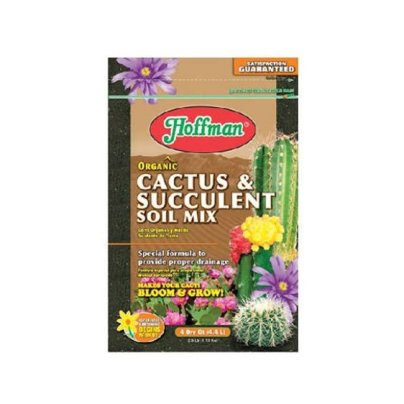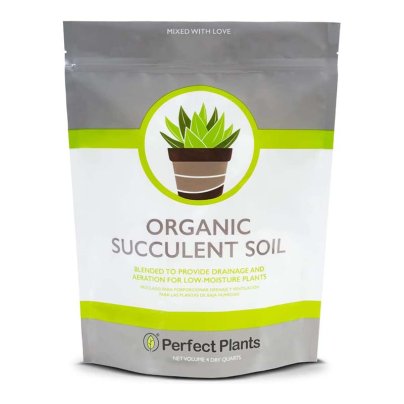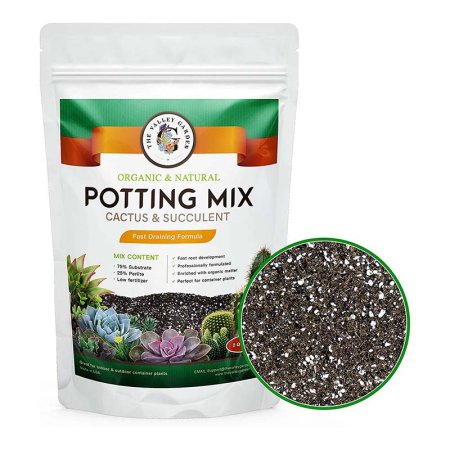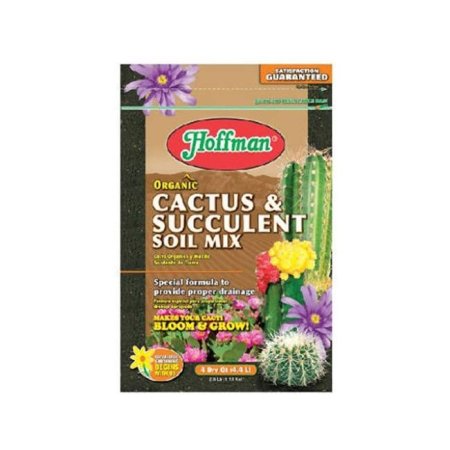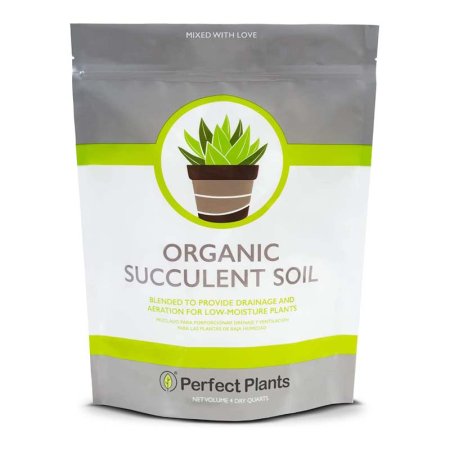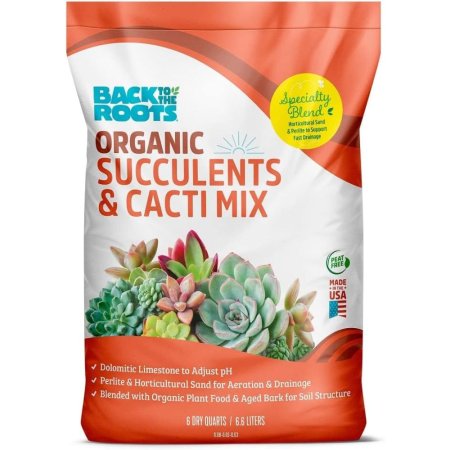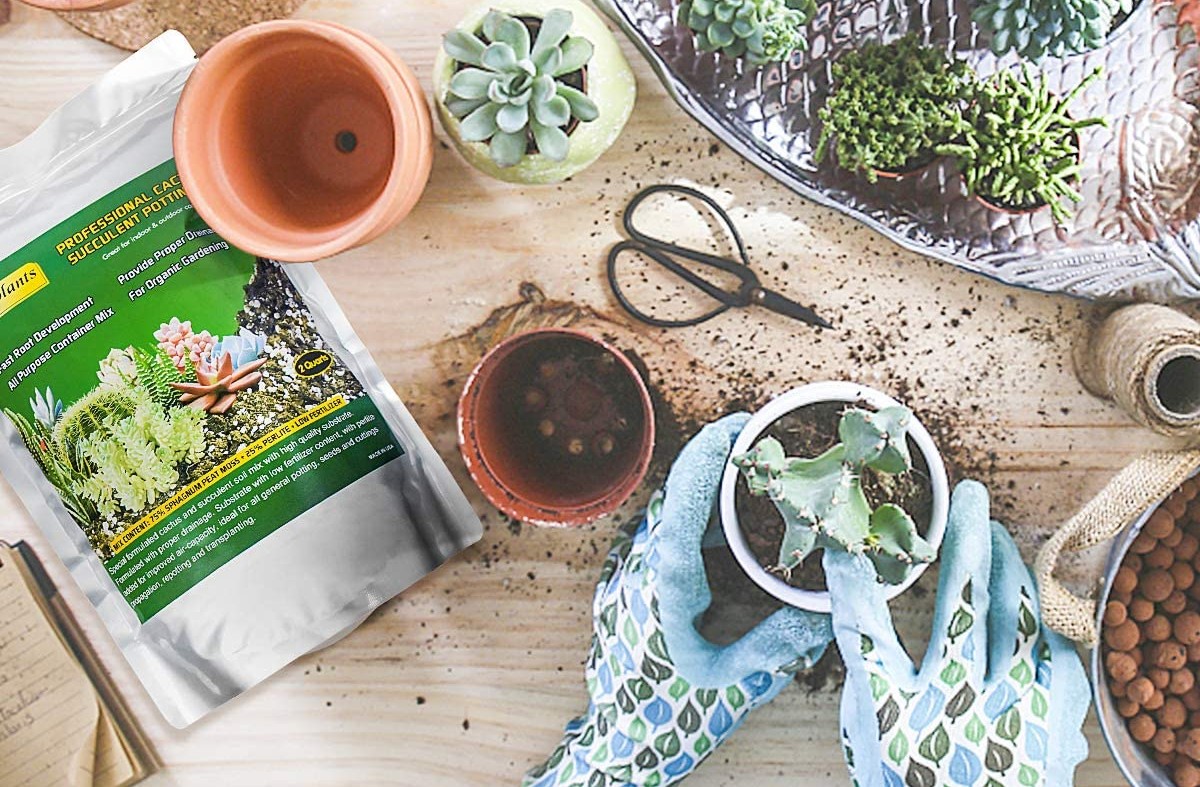
We may earn revenue from the products available on this page and participate in affiliate programs. Learn More ›
Succulents are low-maintenance plants that are perfect for many brown-thumbed gardeners. Since they generally require very little attention, they are also popular houseplants. However, they do need proper care to flourish.
Neglect isn’t the reason most people kill their succulents. The cause is typically giving them too much attention: Too much water spells disaster for succulents. It can lead to root rot and the plant’s eventual demise. Practicing restraint when watering can help avoid the possibility that your succulent plants are sitting in water. The right soil, however, can also prevent excess sogginess.
To help you care for your succulents, we’ve researched the key features of high-quality succulent soils. Our favorite is The Valley Garden Organic Succulent Soil Potting Mix due to its added nutrients, versatile use, and ideal pH level. We’ve gathered some of the best soil options for succulents so you can choose the right soil for your gardening needs.
- BEST OVERALL: The Valley Garden Organic Succulent Soil Potting Mix
↓ Jump to Review - RUNNER-UP: Hoffman Organic Cactus and Succulent Soil Mix
↓ Jump to Review - BEST BANG FOR THE BUCK: Espoma Organic Cactus Mix
↓ Jump to Review - BEST ORGANIC: Perfect Plants All Natural Succulent and Cactus Soil
↓ Jump to Review - BEST FOR OUTDOORS: Bonsai Jack Gritty Mix Succulent and Cactus Soil
↓ Jump to Review - BEST FOR INDOORS: Back to the Roots Succulents & Cacti Mix
↓ Jump to Review

How We Chose the Best Soil for Succulents
Years of experience covering home and garden products as well as extensive product research went into creating this guide. We explored more than 20 soil options and weighed a number of practical considerations before making our recommendations.
- Organic vs. inorganic: While there are plenty of inorganic succulent soil options on the market, we focused our recommendations on organic options because they reduce the risks to our health and/or the environment.
- Drainage: Since many types of succulentsare accustomed to arid climates, one of the most important factors when choosing a succulent soil mix is top-notch drainage. This prevents them from becoming waterlogged.
- Value: Since succulent soil varies widely in quantity, we calculated the overall value based on the amount per cost for each of our recommendations.
Our Top Picks
These succulent soil mixes were chosen because they provide good drainage and quality nutrients for succulent plants. Experiment with different soils to find the brand that works best. Gardeners tend to have varied preferences when it comes to soil mixes of all kinds.
Best Overall
The Valley Garden Organic Succulent Soil Potting Mix
Pros
- This versatile potting mixture can be used for succulents as well as other plants and vegetables
- pH balanced to 5.5, which is the ideal pH level for most types of succulents
- Mixture contains a low level of fertilizer, minimizing how much gardeners need to fertilize their succulents
Cons
- May be harder to find as this product isn’t available at many retailers
- Only comes in 1 size option; limited quantity compared to other soils on this list
Product Specs
- Quantity: 2 quarts
- Key ingredients: Natural substrate and perlite
- pH level: 5.5
The Valley Garden organic succulent and cactus potting soil mix is a coarse, well-draining soil structure that contains a mild fertilizer, making it a perfect mixture for most types of succulents. Formulated with 75 percent natural substrate and 25 percent perlite, this potting mixture contains added nutrients to help succulent plants grow robust, healthy roots.
Its organic matter is suitable for succulents, cacti, and aloe as well as some flowers and vegetables. This potting mixture is designed for a pH level of 5.5, which is considered to be the ideal pH level for growing succulents. It comes in a resealable 2-quart bag for added convenience.
Get The Valley Garden soil for succulents at Amazon.
Runner-up
Hoffman Organic Cactus and Succulent Soil Mix
Pros
- Potting mixture is suitable for both jungle and desert cacti and succulents
- Detailed usage instructions are included for beginners starting succulent gardening
- The combination of sphagnum peat moss, compost, reed sedge peat, perlite, and sand creates a mixture that drains well
Cons
- The quantity of peat in this formula may be too high for some succulents as it may cause the soil to hold water
Product Specs
- Quantity: 4 quarts
- Key ingredients: Canadian sphagnum peat moss, compost, reed sedge peat, perlite, sand, and limestone
- pH level: 6.3 to 7
This organic potting soil for succulents has a pH level that can vary from 6.3 to 7 depending on the compost material at the time of packaging and the limestone added, according to the brand. It contains Canadian sphagnum peat moss, reed sedge peat, perlite, sand, and limestone. This strategic blend of soil and organic matter provides nutrition and optimal drainage for succulent plants. It’s formulated for both jungle and desert cacti, allowing home gardeners to use this product for nearly any type of succulent.
Detailed instructions are included from the manufacturer to help achieve the best results with this soil mix, making it a great choice for beginner succulent gardeners. It comes in a resealable 4-quart bag, which is available at an affordable price compared to many other organic potting mixtures on the market.
Get the Hoffman soil for succulents at Amazon.
Best Bang For The Buck
Espoma Organic Cactus Mix
Pros
- Mixture contains a combination of endo- and ectomycorrhizae to enrich the soil
- Formulated to be suitable for all types of succulents and cacti
- Potting mix features ingredients that are designed to balance the soil’s pH levels
Cons
- Some users have noted that this soil was damp and needed to be dried out when they received it
Product Specs
- Quantity: 4 quarts
- Key ingredients: Sphagnum peat moss, aged forest products, humus, yucca extract, lime
- pH level: Unlisted
When growing succulents indoors, it’s particularly important to choose the right potting soil. The key ingredients in this mixture are sphagnum peat moss, aged forest products, humus, yucca extract, and lime, all of which combine to create excellent drainage.
What makes this product ideal for indoor succulent gardening is that it also contains a blend of endo- and ectomycorrhizae to enrich the soil quality. It’s specifically designed for container gardening and, therefore, may not be the best fit for inground gardens. The manufacturer recommends its soil mixture for all succulents, cactus, palm, and citrus, including jade plants, burro’s tail, aloe vera, and Christmas cactus.
What our tester says: Debbie Wolfe, a Bob Vila writer and product tester, notes the following: “I always trust the Espoma organic cactus mix for my indoor succulents. It’s a premium quality soil mix that is both lightweight and well draining, making it perfect for desert cacti, citrus plants, and a variety of succulents, hoyas, and jungle cacti. Although it is slightly pricier than other options, I swear by it and only use it for my most treasured succulent collection. Overall, the Espoma mix is a reliable choice for any succulent enthusiast looking to cultivate a thriving indoor garden.”
Get the Espoma soil for succulents at Amazon.
Best Organic
Perfect Plants All Natural Succulent and Cactus Soil
Pros
- This potting mixture enriches the soil while simultaneously providing aeration
- Since it’s available in 3 sizes, this potting soil offers excellent value at a variety of different quantities
- Composted pine bark, perlite, and sand combine to facilitate proper drainage and aeration
Cons
- Some users complain that this soil arrived infected with mold
Product Specs
- Quantity: 1 quart, 4 quarts, and 8 quarts
- Key ingredients: Garden coir, composted pine bark, perlite, and sand
- pH level: 6.0
Organic potting soil tends to be more expensive than its inorganic counterparts. This low-cost soil mix from Perfect Plants, however, is intended for potting up small succulents. The 4-quart ziplock-style bag is easy to reseal for indoor storage.
Made with a mixture of coir, composted pine bark, perlite, and sand, the soil’s texture helps provide adequate drainage. In fact, this potting mix is designed to enrich this special soil with nutrients for healthier roots while simultaneously providing aeration to ensure that the plants don’t become waterlogged. According to the manufacturer, it’s suitable for a wide variety of succulent types, including jade plants, string of pearls, zebra plants, aloe vera, and more.
Get the Perfect Plants soil for succulents at Amazon or The Home Depot.
Best For Outdoors
Bonsai Jack Gritty Mix Succulent and Cactus Soil
Pros
- Provides excellent drainage while preventing root rot and disease
- Can be used with succulents, cacti, bonsai, aloe, jade, and crassula
- Formula does not contain any dyes, additives, or pathogens
- Comes in multiple quantities to accommodate the amount of soil users require
Cons
- Some users have reported that this succulent and cactus potting soil mix is too dry for their plants
Product Specs
- Quantity: 2 quarts, ½ gallon, 1 gallon, or 2 gallons
- Key ingredients: Bonsai Block, Monto Clay, and Pine Coir
- pH level: 5.5
Made for excellent drainage and root rot prevention, the Bonsai Jack Gritty Mix succulent and cactus soil is perfect for those who keep their plants outdoors. With a pH balance of 5.5, this pathogen-free gritty soil mix is light and airy to accommodate acid-loving plants including succulents, cacti, aloe, jade, crassula, and even bonsai.
This mix is a combination of Bonsai Block, Monto Clay, and Pine Coir. It forgoes using too much organic matter, keeping dry-climate plants healthy, all without the use of any additives or dyes. For added convenience, this succulent and cactus potting soil mix comes in 2-quart, ½-gallon, 1-gallon, or 2-gallon quantities.
What our tester says: Debbie Wolfe, a Bob Vila writer and product tester, notes that “Bonsai Jack succulent and cactus soil is an ideal potting mix for desert cacti and succulents requiring excellent drainage and root rot protection. The soil is gritty and fast draining, which may not be suitable for succulents like jungle cacti that prefer wetter soil. It is worth noting that this soil is a bit pricey, so if you have a lot of plants to pot up, it can add up quickly. However, the high-quality ingredients and effectiveness of the soil make it well worth the investment, especially for succulents planted outdoors.”
Get the Bonsai Jack soil for succulents at Amazon.
Best For Indoors
Back to the Roots Succulents & Cacti Mix
Pros
- Comes in multiple quantities to accommodate many different potted or outdoor succulents and cacti
- Promotes root growth, aeration, pH levels, and soil structure while preventing root rot
- Reliable, organic brand that uses no synthetic chemicals or animal waste
- Affordable price point compared to some other soils for succulents
Cons
- Some users have reported that this soil can attract insects
Product Specs
- Quantity: 6 quarts and 12 quarts
- Key ingredients: Dolomitic limestone, perlite, horticultural sand, organic plant food, mycorrhizae, and aged bark
- pH level: Unlisted
Indoor succulents and cacti can grow strong and healthy with this mix from Back to the Roots. This 6-quart organic soil for succulents is made with perlite, dolomitic limestone, horticultural sand, organic plant food, mycorrhizae, and aged bark. These ingredients promote healthy root growth, soil structure, ideal pH levels, and drainage in indoor and outdoor succulents and cacti.
This brand also prides itself on avoiding synthetic chemicals and animal waste from factory farms to create truly organic products. Plus, it comes with an affordable price tag.
Get the Back to the Roots soil for succulents at Amazon, The Home Depot (8-pack), or Target.
Or, DIY Your Own Soil for Succulents
While there are many great potting soils available on the market, it can be more affordable to make your own. The first step to making a DIY succulent potting mix is to gather the needed materials: coarse sand, perlite, and sphagnum peat moss. All can be found online or at well-stocked garden-supply stores.
Coarse sand helps with drainage and aeration, while the perlite keeps things light so roots can breathe more easily. Sphagnum peat moss provides insulation for the roots of succulents and helps retain moisture. An ideal ratio would be about two parts coarse sand, one part perlite, and two parts sphagnum peat moss.
Jump to Our Top Picks
Our Verdict
After reviewing this guide, you now know which soils for succulents made the cut. We recommend The Valley Garden Organic soil for succulents as our top pick because it’s well draining and contains added nutrients.
There are other popular succulent soil options on the market, including Miracle-Gro Cactus, Palm & Citrus Soil and FoxFarm Happy Frog Potting Soil. However, they do not meet our sustainability guidelines and are not recommended in our top picks due to their potentially harmful ingredients and negative impact on the environment.
What to Consider When Choosing a Soil for Succulents
Potting succulents in the wrong soil will quickly put a stop to any gardening adventures. In unsuitable soil, succulents will become stressed, waterlogged, and eventually die. While some succulents are hardier than others, the right soil will boost the health of any succulent plant. Most succulents (and cacti) hail from dry climates with very little rainfall, so they do not respond well to heavy watering and ultramoist soil.
Indoor vs. Outdoor
There are plenty of indoor houseplant soils on the market made especially for succulents—but is it possible to find soil for growing succulents outside? An important consideration for outdoor growing is the volume of soil needed. Outdoor conditions are very different from indoor ones.
Plants tend to get more sun and airflow outdoors, which helps prevent water-soaked soil. It is possible, therefore, to be a bit less cautious when choosing planting soil for outdoor succulents. However, it’s still important to choose a mix that promotes excellent drainage.
Soil vs. Mineral Ratio
All soils contain a mixture of organic substances and minerals. When shopping for soil for succulents, the soil structure is of utmost importance. Succulent soil has more mineral content in it than soil. Organic substances hold on to water and deliver nutrients to plant roots, while minerals help promote soil drainage. The materials that make up the soil mix can also affect pH levels, which are optimally maintained at 5.5 to 6.5 for succulents.
The mineral-to-organic-content ratio depends on the type of succulent being grown. Choose soil with a sandy texture for most succulents, as it will also improve drainage. A soil with too much organic matter can cause soil compaction.
Container and Drainage
Avoid potting succulent plants in containers without drainage holes. Add rocks or gravel to the bottoms of pots to further encourage drainage, but drainage holes are an immense help in preventing root rot.
A plant pot with drainage holes and a saucer helps make it easy to spot plants that are being overwatered. Also consider keeping succulents in nursery pots and pop them into cachepots, but don’t forget to regularly check the bottom of the pot for water accumulation after watering.
FAQs
Do you still have burning questions about soil for succulents? Here are a few answers to frequently asked questions on the subject.
Yes. Succulents (and cacti) are native to dry, arid climates, so they prefer sandy, well-draining soils over clay soils or regular potting soil. If you were to use the soil in your vegetable garden, which is formulated to retain water for thirsty plants, your succulents would quickly die off. Specially formulated soil mixes designed for your succulent plant are recommended, especially for new gardeners.
A sandy, porous soil is ideal. A soil composed of at least 50 percent materials like perlite, coarse sand, and other minerals will help promote drainage. The higher the mineral content, the better the drainage.
Rocks are a helpful addition to succulent soil mixes because they improve drainage. Water slips through stones easily. However, succulent plants need some soil to survive; otherwise they do not have access to nutrients. If you spot a rock garden adorned with succulents, you might not see the bottom layer of soil underneath, but it’s definitely there.
You can, but it doesn’t mean you should. Holes ensure proper drainage. Without holes, watering becomes a bit of a risky activity. If you have a plastic pot without holes, you can add them yourself using a drill. Materials like glass require expert attention and specialty tools, so you should avoid trying to alter those.
If you prefer to use a container without drainage holes, you can add rocks, marbles, or other substrate at the bottom of the container to help with drainage, and then water the plant sparingly.
There are many benefits to having houseplants. They beautify rooms and bring the outdoors indoors. Some houseplants can also help purify the air in your home and help increase ambient humidity. There’s also evidence that plants can improve your overall well-being and mental health by reducing stress and anxiety.
Succulents are easy to care for and an excellent choice for neglectful gardeners who still wish to enjoy the benefits of having houseplants around. Many succulents also produce “babies” and are simple to propagate, so a single plant will eventually lead to more down the road. You don’t need to cater to unique needs like those of some tropical houseplants. Most succulents will also survive in small pots as long as they have good drainage. And, of course, they look very cool.

